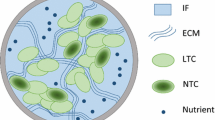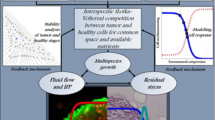Abstract
The experimental evidence that a feedback exists between growth and stress in tumors poses challenging questions. First, the rheological properties (the “constitutive equations”) of aggregates of malignant cells are still a matter of debate. Secondly, the feedback law (the “growth law”) that relates stress and mitotic–apoptotic rate is far to be identified. We address these questions on the basis of a theoretical analysis of in vitro and in vivo experiments that involve the growth of tumor spheroids. We show that solid tumors exhibit several mechanical features of a poroelastic material, where the cellular component behaves like an elastic solid. When the solid component of the spheroid is loaded at the boundary, the cellular aggregate grows up to an asymptotic volume that depends on the exerted compression. Residual stress shows up when solid tumors are radially cut, highlighting a peculiar tensional pattern. By a novel numerical approach we correlate the measured opening angle and the underlying residual stress in a sphere. The features of the mechanobiological system can be explained in terms of a feedback of mechanics on the cell proliferation rate as modulated by the availability of nutrient, that is radially damped by the balance between diffusion and consumption. The volumetric growth profiles and the pattern of residual stress can be theoretically reproduced assuming a dependence of the target stress on the concentration of nutrient which is specific of the malignant tissue.








Similar content being viewed by others
References
Folkman, J., Hochberg, M.: Self-regulation of growth in three dimensions. J. Exp. Med. 138(4), 745–753 (1973)
Ambrosi, D., Mollica, F.: The role of stress in the growth of a multicell spheroid. J. Math. Biol. 48(5), 477–499 (2004)
Greenspan, H.: Models for the growth of a solid tumor by diffusion. Stud. Appl. Math. 51(4), 317–340 (1972)
Helmlinger, G., Netti, P.A., Lichtenbeld, H.C., Melder, R.J., Jain, R.K.: Solid stress inhibits the growth of multicellular tumor spheroids. Nat. Biotechnol. 15(8), 778–783 (1997)
Montel, F., Delarue, M., Elgeti, J., Vignjevic, D., Cappello, G., Prost, J.: Isotropic stress reduces cell proliferation in tumor spheroids. New J. Phys. 14(5), 055008 (2012)
Forgacs, G., Foty, R.A., Shafrir, Y., Steinberg, M.S.: Viscoelastic properties of living embryonic tissues: a quantitative study. Biophys. J. 74(5), 2227–2234 (1998)
Kuznetsova, T.G., Starodubtseva, M.N., Yegorenkov, N.I., Chizhik, S.A., Zhdanov, R.I.: Atomic force microscopy probing of cell elasticity. Micron 38(8), 824–833 (2007)
Cheng, G., Tse, J., Jain, R.K., Munn, L.L.: Micro-environmental mechanical stress controls tumor spheroid size and morphology by suppressing proliferation and inducing apoptosis in cancer cells. PLoS ONE 4(2), e4632 (2009)
Netti, P.A., Berk, D.A., Swartz, M.A., Grodzinsky, A.J., Jain, R.K.: Role of extracellular matrix assembly in interstitial transport in solid tumors. Cancer Res. 60(9), 2497–2503 (2000)
Stylianopoulos, T., Martin, J.D., Chauhan, V.P., Jain, S.R., Diop-Frimpong, B., Bardeesy, N., Smith, B.L., Ferrone, C.R., Hornicek, F.J., Boucher, Y., et al.: Causes, consequences, and remedies for growth-induced solid stress in murine and human tumors. Proc. Natl. Acad. Sci. 109(38), 15101–15108 (2012)
Ambrosi, D., Mollica, F.: On the mechanics of a growing tumor. Int. J. Eng. Sci. 40(12), 1297–1316 (2002)
Montel, F., Delarue, M., Elgeti, J., Malaquin, L., Basan, M., Risler, T., Cabane, B., Vignjevic, D., Prost, J., Cappello, G., et al.: Stress clamp experiments on multicellular tumor spheroids. Phys. Rev. Lett. 107(18), 188102 (2011)
Monnier, S., Delarue, M., Brunel, B., Dolega, M.E., Delon, A., Cappello, G.: Effect of an osmotic stress on multicellular aggregates. Methods 94, 114–119 (2016)
Byrne, H., Preziosi, L.: Modelling solid tumor growth using the theory of mixtures. Math. Med. Biol. 20(4), 341–366 (2003)
Ambrosi, D., Preziosi, L.: On the closure of mass balance models for tumor growth. Math. Models Methods Appl. Sci. 12(05), 737–754 (2002)
Roose, T., Netti, P.A., Munn, L.L., Boucher, Y., Jain, R.K.: Solid stress generated by spheroid growth estimated using a linear poroelasticity model. Microvasc. Res. 66(3), 204–212 (2003)
Ambrosi, D., Guana, F.: Stress-modulated growth. Math. Mech. Solids 12(3), 319–342 (2007)
Chanet, S., Martin, A.C.: Mechanical force sensing in tissues. Prog. Mol. Biol. Transl. Sci. 126, 317 (2014)
Ciarletta, P.: Buckling instability in growing tumor spheroids. Phys. Rev. Lett. 110(15), 158102 (2013)
Destrade, M., Murphy, J.G., Ogden, R.W.: On deforming a sector of a circular cylindrical tube into an intact tube: existence, uniqueness, and stability. Int. J. Eng. Sci. 48(11), 1212–1224 (2010)
Alnæs, M., Blechta, J., Hake, J., Johansson, A., Kehlet, B., Logg, A., Richardson, C., Ring, J., Rognes, M.E., Wells, G.N.: The FEniCS project version 1.5. Arch. Numer. Softw. 3(100) (2015)
Geuzaine, C., Remacle, J.-F.: Gmsh: A 3-D finite element mesh generator with built-in pre- and post-processing facilities. Int. J. Numer. Meth. Engng. 79, 1309–1331 (2009)
Balay, S., Abhyankar, S., Adams, M.F., Brown, J., Brune, P., Buschelman, K., Dalcin, L., Eijkhout, V., Gropp, W.D., Kaushik, D., et al.: PETSc users manual. Technical Report ANL-95/11—Revision 3.6. Argonne National Laboratory (2015)
Amestoy, P.R., Duff, I.S., L’Excellent, J.Y., Koster, J.: A fully asynchronous multifrontal solver using distributed dynamic scheduling. SIAM J. Matrix Anal. Appl. 23(1), 15–41 (2001)
Mascheroni, P., Stigliano, C., Carfagna, M., Boso, D.P., Preziosi, L., Decuzzi, P., Schrefler, B.A.: Predicting the growth of glioblastoma multiforme spheroids using a multiphase porous media model. Biomech. Model. Mechanobiol. 15(5), 1215–1228 (2016)
Ambrosi, D., Preziosi, L.: Cell adhesion mechanisms and stress relaxation in the mechanics of tumours. Biomech. Model. Mechanobiol. 8(5), 397–413 (2009)
Dorie, M.J., Kallman, R.F., Rapacchietta, D.F., Van Antwerp, D., Huang, Y.R.: Migration and internalization of cells and polystyrene microspheres in tumor cell spheroids. Exp. Cell Res. 141(1), 201–209 (1982)
Delarue, M., Montel, F., Caen, O., Elgeti, J., Siaugue, J.M., Vignjevic, D., Prost, J., Joanny, J.F., Cappello, G.: Mechanical control of cell flow in multicellular spheroids. Phys. Rev. Lett. 110(13), 138103 (2013)
Acknowledgements
The work has been partially supported by the My First AIRC Grant—MFAG 2015—code 17412 titled “A Mathematical insights of glioblastoma growth: a mechano-biology approach for patient-specific clinical tools” and by “Progetto Giovani GNFM 2016” funded by the National Group of Mathematical Physics (GNFM—INdAM). TS is supported by European Research Council (ERC-2013-StG-336839).
Author information
Authors and Affiliations
Corresponding author
Appendix: Stability of the Homogeneous Solution
Appendix: Stability of the Homogeneous Solution
The integration of the “stress-modulated growth” illustrated in the previous section predicts a spatially homogeneous solution, parametrically depending on the time-dependent growth rate. The growth \(g(R;t)\) is independent of the radial position because the stress is the same everywhere. In such a purely mechanical setting we now study the stability of the homogeneous solution (20) and (25). In other words, the question is whether the spatial inhomogeneity observed in grown spheroids could be produced by the mechanobiological feedback, thus amplifying the spatial perturbations of the stress to yield inhomogeneous growth.
To investigate this hypothesis we consider the following perturbation of the homogeneous solution:
where \(\gamma \) and \(g_{0}(t)\) are solutions of Eqs. (21) and (24), respectively, and \(g_{0}(0) = 1\).
When the perturbed solutions are plugged in Eqs. (21) and (24) and only first order terms are retained, the following linear equations are found
Derivation of the former equation in space, derivation of the latter in time and cross substitution yields
which determines the evolution in time of the spatial perturbation in the growth \(g(t)\). Instability shows up if
for some \(1< g_{0}(t)< g_{e}\), where \(0 <\gamma (p_{D})<1\).
The result (37) is negative versus our conjecture: it predicts a stabilization of the system for large enough growth \(g_{0}\) which is not in agreement with experiments. If the purely mechanical system is stable, the reported inhomogeneity (large proliferation near the boundary, smaller internally) should instead be explained accounting for the role of nutrients.
Rights and permissions
About this article
Cite this article
Ambrosi, D., Pezzuto, S., Riccobelli, D. et al. Solid Tumors Are Poroelastic Solids with a Chemo-mechanical Feedback on Growth. J Elast 129, 107–124 (2017). https://doi.org/10.1007/s10659-016-9619-9
Received:
Published:
Issue Date:
DOI: https://doi.org/10.1007/s10659-016-9619-9




